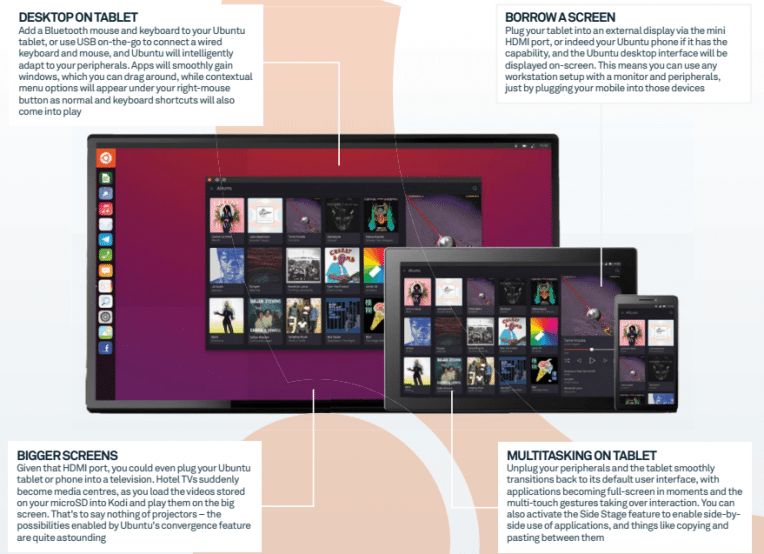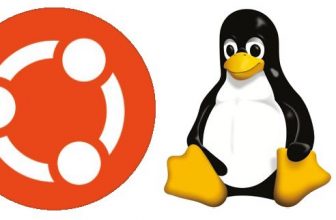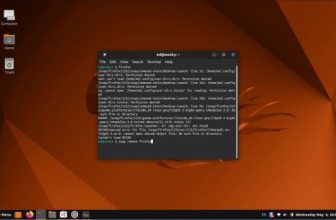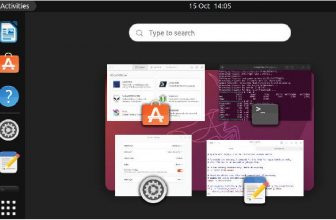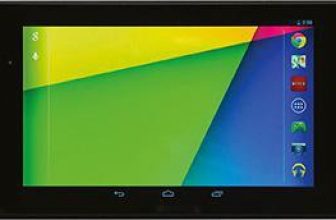
Table of Contents
[sc name=”ad 2″]
WHATS NEW FOR 16.04?
Discover whats shipping with your new Long-Term Support release
Ubuntus Long-Term Support releases are, by definition, designed to be highly stable improvements with minimal disruptive changes. 16.04 is no different, and that’s why the majority of the visible changes are based on bugfixes and incremental quality improvements, as noted in the release log – see the Package Updates box above for a quick round-up. That said, however, there are a number of other surprises that emerge in particular use cases – not to mention the convergence features themselves, covered on pages 24-25.
Unity 8 has been in the spotlight for a while now and finally makes its grand entry in 16.04. It is not, however, used as the default window manager for Unity. Given that this is an LTS, Canonical decided notto make this the transition release and has instead opted to leave Unity 7, based on the Wayland display server, as the default, while including Unity 8, based on the Mir display server, as an option for users and available on the login screen. Mir appears, though, to be highly stable and we encourage you to check it out once youve upgraded to the new distro.
Unity and the Compiz compositing manager have also seen some refinements. The launcher has been improved and now integrates with the file manager and devices, and can also be moved to the bottom of the screen. Scrollbars for the Dash overlay have been added and there is now better support for design elements like the headerbars and improvements to the backends for things like the application spreader and switcher. The application spreader can now be activated by hitting Super+Ctrl+W, too. As well as this, there have been updates to things like GNOMES key grabbing, HiDPI support, and app icons in the launcher will now display the application state.
Server and OpenStack
16.04 isn’t just about the desktop edition, however. Jane Silber. CEO of Canonical, explains how Ubuntu Server edition is an exciting release for business owners worldwide: So you have this notion of a machine container, which is distinct from a Docker container fie an application container] in that it is still a container – it still runs on bare metal – but it acts and looks like a virtual machine: to the application running inside it its going to look like a VM. If you want to add a monitoring agent or a logging agent, you can’t do that to a Docker process, but inside of a machine container you can – you treat it like a VM. You can even run Docker inside a machine container.
Weve had it in beta for a while, but that technology comes to life in 16.04. LXD essentially allows you to create machine containers, and they will still give you container-class performance and container-class light weight, if you will, so that 30-40% of the overhead relative to a VM is gone because you’re running on bare metal, and if you nest one inside the other you will still always be running on bare metal. But you’re getting the encapsulation, the security, and some of the ease of management that comes with being a VM.
So LXD, to us, is a big step – we’re not just announcing it in Server as is. So anybody using Server itself gets the benefit of LXD, but were also adding it into OpenStack. so an OpenStack cloud can now provision not just a VM, but can also provision LXD containers and run processes inside those. We showed some benchmarking results on this last year (this was about eight months ago. roughly) where just in our tests – pound for pound, same workload, same class of machine – running everything in LXD would be about 14 times more dense in terms of what you’d get out of the machine compared to running it in classic VMs.
The other big one for us in terms of 16.04 is ZFS. It comes up a lot in conversation – people love ZFS for many different reasons – and it was always the killer app for Solaris, back in the day. ZFS is now part of 16.04. so Ubuntu users everywhere – Netflix, Airbnb, Spotify. all those people – now have access to this as an added feature of Ubuntu, if they choose to use it.
Those would be two big things I’d call out The other big thing is… OpenStack updates every six months. We release on the same cadence and essentially publish on pretty much the same date as when OpenStack updates. So 16.04 becomes the LTS. the Long-Term Support release, for Ubuntu OpenStack as well. For all of the customers that are in conversations with us, that are just starting out, this now becomes a release they can get on where they know they will have long-term support upon what we stand behind and around 16.04.”
Below Combine the power of a container with the ease of a VM
Bottom ZFS makes it easier to find what youre looking for
Smartphones & tablets
We go hands-on with the latest device from Canonical
Last year saw the release of the BQ Aquaris E4.5and E5 HD models, plus the Meizu MX4Ubuntu Edition. At MWCthis year Canonical launched the new Meizu Pro 5 smartphone. Down at the Blue Fin building, however, we got to play with somethingquite special-the BO Aquaris MIOUbuntu Edition. Canonical’s first tablet.
It’s a solid device, well-built and lovely to use – you can find the full specs in the info box (p22) – and the convergence features (p24) transform it into a powerful, multipurpose computer that has all the advantages of being a mobile device. In terms of its specs and build quality, the M10 is neither revolutionary nor high-end – but it’s not going for that end of the market At 210-240, the Ubuntu tablet is coming in cheaper than the current Apple and Android tablets, while also offering the ability to seamlessly change the way you’re using the screen so that it is either in tablet mode or acting as a display for the full desktop. That’s the revolutionary aspect of this device, and one that will help push it into the tablet market at both the home and business ends of the spectrum. Pre-orders should be live by the time we go to press, and the tablet will begin shipping in early April.
The response to the tablet has been really exciting and overwhelming in many ways.” says Silber. which I think has caught many people by surprise, because there’s a group of sceptics who say Tablets? The tablet market is dying – why are you going into that field?* For us, it’s almost incidental that its a tablet – it’s showing that the stack can run on any size screen and real estate, and behave in an appropriate way.”
The Internet of Things
Ubuntu Core is spreading beyond the smartphone and into the smart home, bringing to life an exciting new wave of loT gadgets
I think the place where well see a lot of traction, says Silber, where you should keep your eyes peeled, is around Ubuntu Core and adoption by device manufacturers. I think we’ll put out a GA version of Ubuntu Core post-16.04 – it’s not quite going to be ready in the late April timeframe – and then I expect that to unleash a wide range of adoption across a number of verticals. We’ve mentioned robots and drones before, networking and gateways -1 think well see things in the digital signage area, a market that’s ripe for Ubuntu Core.
And I think well start to see the opening of those vertical markets based on Ubuntu Core in the next six months. We will see some additional announcements around the phone and personal computing, including working with some of the major carriers. We initially took a very specific strategy in the go-to-market approach of working with the online retailers – BO and Meizu both sell directly to consumers online and not through carriers. I expect that in the next six months we’ll start to see more carrier involvement in our phone and personal computing strategy.
IoT and Ubuntu Core is one of those pieces that spans from top-of-rack switches in data centres to robots and drones in consumer- and prosumer-land. With the question of how quickly it’s being adopted, it’s very rapidly and particularly in a couple of specific verticals that we’ve been focused on. In the gadget world, when people talk about loT they think about robots and drones – Ubuntu and Ubuntu Core has been adopted by the ROS (Robotics Operating System) community, and so most of the work that’s happening on a ROS-based infrastructure is happeningon Ubuntu Core. A lot of autonomous vehicles, the leading drone manufacturers – we had a collection of little robots at M WC runningUbuntu Core that are just proliferating: I think we’re in line for a lot of really interesting innovation there, driven not just by the goodness of the Ubuntu platform but also the app ecosystem that it opens up.
One of the key parts of the Ubuntu Core strategy is enabling devices to be software-defined, the same way you can have a software-defined network and virtualised network functions in the telco space, and creating that ecosystem on top of the devices. We see a lot of attraction in networking equipment – both home networking and the data centre kinds of networking in industrial loT gateways, and in the ecosystem overall in terms of relationships with folks like Samsung and Qualcomm. NVIDIA and Intel, who are building specific silicon aimed at loT devices, and they know that the people building devices with that silicon want to build them with Ubuntu. so there’s a lot of really interesting ecosystem enablement happening now as welL”
Below The Ubuntu Core strategy will enable loT devices to be software as well as hardware-defined
Ubuntu: The converged OS
What does convergence mean and why is this important to the user? Canonicals CEO explains
Convergence is the stand-out feature of Ubuntu 16.04 – it describes the convergence of the Ubuntu operating system across device platforms, such that this is now the exact same code running across Ubuntu on your desktop, your smartphone and the tablet, as well as servers and loT devices. What this unified code base enables is the implementation of software that just works across all of these devices, without having to be individually ported to each one. We asked Jane Silber just how deep this convergence goes – whether it is simply responsive design, with the Ul reflowing to fit that detected hardware, or whether Ubuntu is working at a deeper level, deploying specific parts of the kernel.
Its a very good question.” begins Silber. Is it just responsive design? I would take the justout of that, because I think responsive design by itself is a very interesting and challenging topic. There absolutely is a part of it that is responsive design at the user experience level – the Unity shell knows how to reflow applications or reflow scopes across a larger screen, and that is an important part of it. But it goes lower than that. too. There is. particularly in the full vision of convergence – and were not there yet: this is an evolutionary path – much more knowledge of what hardware capabilities are. We see the first instantiation of this in Ubuntu Core now: the Ubuntu Core architecture is coming back into the phone and desktop piece – that’s a pieceof the convergence of the underlying OS that is still a work in progress.
But that notion of knowing what the hardware is. making different apps available based on your device’s capability, is also an element of convergence. That’s not all in place right now. but there is convergence at the kernel level. The vision, where we’re aiming, is that Ubuntu Core really is just the phone without the user experience, that it is the exact same code, and much of the design principles and motivation for Ubuntu Core has come out of the mobile phone space in terms of how we do updates in a transactional way. We are able to do over-the-air updates on a cadence that’s not our traditional six-month cadence, and to do that app isolation in a secure way. above the core OS.”
Canonical has a clear vision when it comes to convergence and its cloud strategy, but how difficult is it to implement such a vision when you’re working with open source communities?
We asked Silber what challenges there have been in bringing the convergence vision to bear in terms of working with a community-led distro. By and large, the community is very excited by convergence from what we see.” she replies. They’re absolutely on board with the vision, particularly app developers who have this really slick SDK now to be able to develop apps. where the SDK will do the work of reflowing across the screen sizes of various folks, and it’s put a real boost into the application development community, to be able to target this kind of device in a way that is new and exciting. So I wouldn’t say there’s particular challenges around the community and acceptance of convergence -1 think there’s more than acceptance: theres excitement there!
There are some challenges in the fact that we’re not starting from a blank piece of paper. We have a long history of Ubuntu Desktop – we have tens of millions of install bases out there
Below Your laptop, desktop and tablet are all running the same code in the latest Ubuntu 16.04
already – and so those technology transitions can be challenging at times. For example, in 16.04 we took a decision to not make Mir the default. Unity 7 is still the default and Unity 8 is the new Mir-based option, because we don’t want to rush that transition, and because it’san LTS we’re erring on the side of being a little bit conservative in that regard. We think Mir’s in great shape but there are considerations you take into account when you’ve got a large install base and a passionate community.
So there are some challenges around that in terms of the convergence plan, but I think the community’s excitement is one of the things that makes us excited about it as well. It’s very rewarding when you put out a vision and a product, and other people get excited about it. and it has a virtuous circle kind of effect back into Canonical and our development teams.*
And the end goal for the convergence vision? It’s an evolution, in the way that there will be innovation on the hardware side as well, as people leam what can be done, and in the coming years there’ll be a whole impact of augmented reality in terms of how we interact with our devices. One of the limiting factors here is access to a screen, and needing screen space – so as I said you can have a phone and a keyboard and mouse, but it’s not going to be very productive; the limitation there is the screen size.
Well, you can imagine a world where you dont need a screen, where something’s projected from your glasses or some other environment where you’re interacting with your desktop via hand gestures. I think that brings us into that reinvention of personal computing that we find soexciting. and that will influence the convergence play. The end game isn’t just a phone that you can plug into a big screen – the end game is an entirely new way that we interact with our computing devices at a personal leveL”
Below More than simply responsive design, the unified Ubuntu is running across devices at kernel level
Conquering the cloud
Anand Krishnan explains how network function virtualisation and cloud computing are revolutionising the way that services can enter your home
Let me just tell you whats going on, begins Krishnan, EVP & GM for Canonicals Cloud. Cloud has been around as a buzzword for at least seven or eight years now, and a reality – people building things – Id say for the last three or four. The notion of things becoming software- defined. as opposed to a piece of hardware that’s static, has gradually taken hold. Put those things together and you get an explosion of people essentially taking things that were previously thought of as static and making them increasingly software-defined, and using the principles that people have learned from the cloud to bring those to life, architecture-wise and so on. So. an example of what that would look like: take Netflix, the poster child for how you run a big service that, historically, would have been massive amounts of machines and possibly dedicated hardware. Now it’s allVMs running on Amazon, and possibly a couple of other clouds by now – that’s a good example of ‘cloud native: a company that is DevOps-first.
Companies on the more traditional side of the spectrum – telcos – take the same approach when they look at some of what’s going on in software-defined. Take the world of network functions: think of everything a telco has to do in order to make your phone work: every time your phone dials out there is IMS. there’s a set of services that transmit voice, there’s a set of services that transmit data – there’s a whole set of infrastructure that is put in place, country by country, to support all of that across fixed line, wireless, internet connections, cable, digital TV. A lot of that can now be decoupled and you can have it software-defined: you can essentially the deliver the service as software running on commodity hardware. The telco world calls this Network Function Virtualisation’ (NFV): it’s basically taking network functions and making them software-defined. In practise, the reason its possible now and wasnt so possible five years ago. what you’re actually doing is building a cloud, running apps on it – except that one app will deliver your cellphone service, another app will deliver a VPN service and then you’re duplicating those in exchanges in all the countries you’re doing business in. You can even extend some of that capability down to the user-end environment, to the user’s home, by virtue of. for instance, a set-top box something that you’d usually think of as a static device that updates its device once every year, maybe, can now be something that is truly a server running applications, that a telco can drop and remove services onto depending on what you opted for.
“People are taking problems that were historically solved by large software running on large machines, or by some black box thing, and making them software-defined and applying cloud principles in bringing them to life. That is where we are focused – enabling that end of it. There are two parts to making that become real: there’s building the cloud and there’s running the cloud. It sounds kind of prosaic, but a lot of the attention has historically been focused on what it takes to build a cloud. Now. Amazon runs public cloud – they run data centres at volume around the world – and they tackled this problem about eight years ago. You go from running a big database on a big machine to hundreds of thousands of servers across multiple countries. When somebody spins up a whole bunch of workloads on Amazon, Amazon doesn’t send an army of consultants into the data centre to deploy all of that stuff – it just happens automatically. Theyve built a whole bunch of tooling software in order to make that happen.”
Below What are you running in VM that you should be running in a container?
Canonicals cloud
So there’s two sides to it “explains Krishnan. One is building the cloud, which is where Ubuntu Server comes in. There we focus really on how we get people to run infrastructure that stands up fast, is stable, will scale, and will provide that telco- grade capability that you need for some of the scenarios that we’re talking about. The harder and the more practical problem is what you do when your cloud is up. how you operate it at cloud scale, how you take the processes you’ve developed to run ten machines and now apply them to when you’re running five hundred, or a thousand, or tens of thousands – that’s where the word ‘automation’ takes on a whole new meaning.
So we play on both sides of that equation. Ubuntu Server is the tip of that spear in terms of infrastructure, essentially allowing people to do more with less. Server is what Netf lix uses – that’s the baseline OS for everything – but take Sky, and they’re using Ubuntu and they’re using OpenStack as well.
The last piece of the puzzle, though, when you stand the cloud up, is how do you run operations in a way that is cloud- defined as welt? Most of the world does what we would broadly call script-driven – they write scripts that do things. When you do something else, you update your script When you want to do five things that are variants of the same thing, you write five different scripts, or five different versions of it. That doesn’t scale to a world of cloud – it doesnt scale to thousands of nodes. Our approach is model-driven – you essentially take operations and encapsulate that intelligence into a model and the model then does a lot of things that a human would otherwise be doing. So take OpenStack as an example – we can stand up an OpenStack workload (that’s the install process on it), but once it’s up and running, your customers are going to be asking for things to be deployed on top of it. and sometimes they will want those bundles – it might be big data, as an example – to be deployed to that OpenStack environment, and sometimes you’ll find someone saying that they want to see that exact same bundle but configured slightly differently, they only want to see it on a public cloud. Allowing both of those to happen without having to sign up whole new projects and spend months doing it, is done through a product we call Juju, and that’s at the heart of that model-driven approach.
“My call to action to your readers would be… using Ubuntu today – downloading 16.04 and askingyourself. what areyou running in aVM that you should be running in a container? You’re getting production-grade containers built into an operating system, which just hasnt happened before.”
Microsoft and Canonical
We asked Krishnan to explain a little more about the partnership between Canonical and Microsoft in terms of their respective cloud offerings. OpenStack and Azure, as well as the ‘hybrid’ clouds that comprise both these and other platforms. Microsoft’s goal is to let Azure and Azure Stack be mirrors of each other in the long run,” explains Krishnan. So ideally, the Azure API in the public cloud looks just like the Azure Stack API in the private cloud, and so it gives a user that has come into one or the other the ability to go to the other side of the equation: that’s what the play there is. Today, about 70 per cent of all the scale-out out there on any public cloud today is Ubuntu Server already: so the vast majority of Linux running on Azure today is Ubuntu. The same is true for Amazon, the same is true for Google, etc. So the partnership is in terms of extending that down to making that as much a part of Azure Stack as a natural extension. The folks that flock to Azure today and are using Linux will expect to find Ubuntu Server on Azure and they will expect to find it in Azure Stack, so that’s really where that is geared in terms of the work with them, and our goal is to make that a really seamless experience across both environments.”
Below The Canonical team hard at work on bringing Ubuntu 16.04 to you


